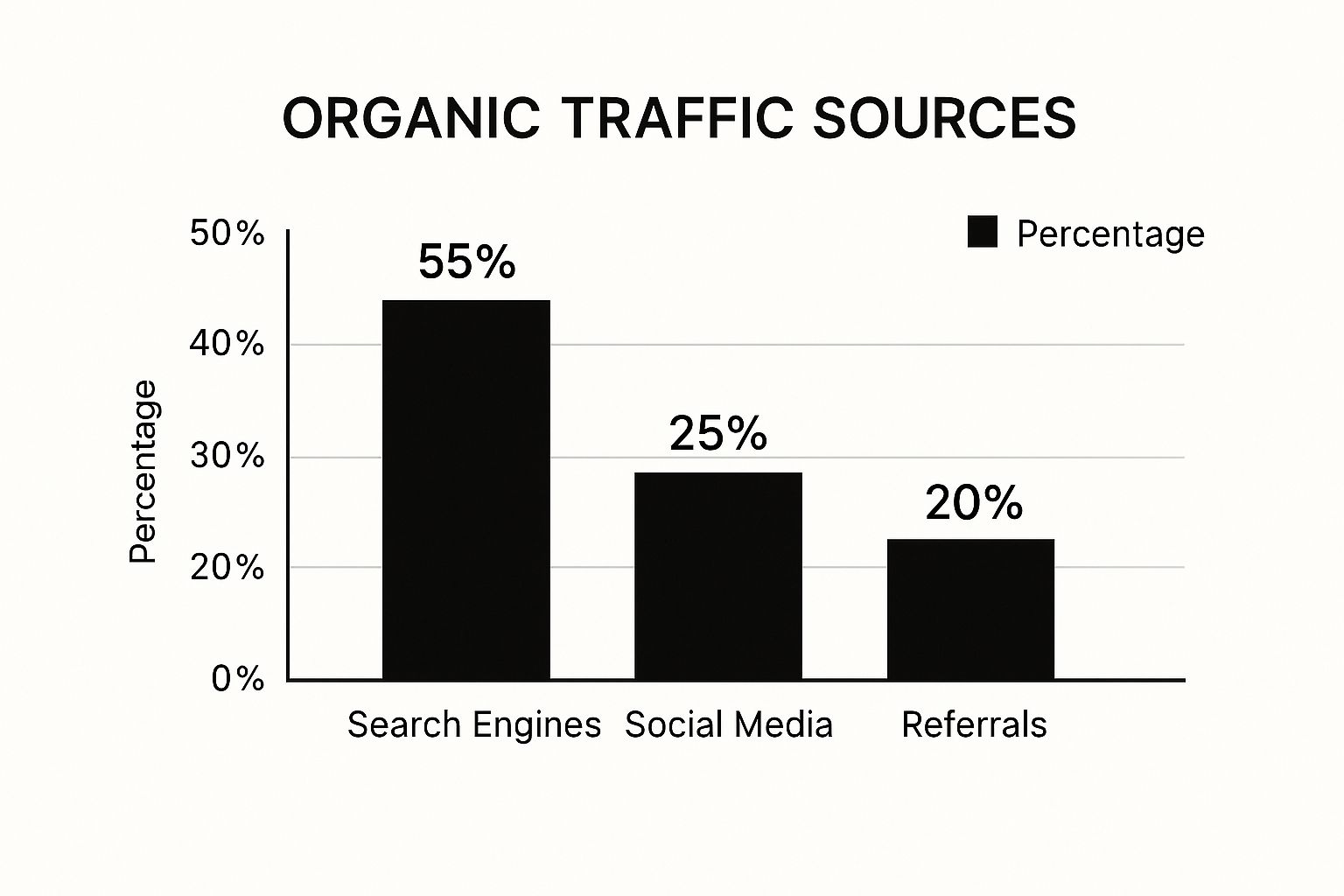To really drive organic traffic, you have to nail three things: creating genuinely helpful content, making sure search engines can actually find and understand your site, and building authority with high-quality backlinks. Forget quick wins; this is a long game built on trust and relevance.
Before you start tweaking title tags or hunting for links, you need to get your mindset right. Growing organic traffic isn't about chasing algorithms. It's about building a real, long-term asset for your brand.
Think of it like building a house. You wouldn't put up walls without a solid foundation, right? The same goes for your website. Without that strong base, any traffic you manage to get will eventually disappear.
This foundation is built on a simple truth: organic traffic isn't just "free clicks." These are people actively looking for answers, and they trust search engines to give them the best ones. That trust is exactly why organic traffic is so valuable.
You can't overstate how much it matters to land at the top of the search results. Most people simply don't click on ads. In fact, a staggering 94% of clicks on Google go to organic results, leaving just 6% for paid ads.
Even more telling, that number one organic spot grabs an average click-through rate (CTR) of 27.6%. That's a huge slice of the pie, and it shows just how much of an advantage you get by outranking everyone else.
While everyone obsesses over Google (and for good reason), a truly healthy organic strategy doesn't put all its eggs in one basket. Knowing where your visitors come from helps you decide where to put your time and effort.
This chart gives you a pretty typical look at where organic traffic comes from for a site that’s doing things right.

As you can see, search engines are the main driver, but social media and direct referrals are critical supporting players. If you want to dig deeper, these essential strategies to increase website traffic offer a great overview of how these pieces fit together.
To put a bow on it, this guide breaks down the core strategies you'll need to master. We've organized them into a simple framework to show how everything connects.
Strategy PillarPrimary GoalKey ActionsOn-Page & ContentSatisfy user intent and rank for relevant keywords.Keyword research, content creation, and on-page optimization.Technical SEOEnsure search engines can crawl, render, and index your site efficiently.Site speed optimization, sitemap management, and fixing crawl errors.Off-Page AuthorityBuild trust and authority through external signals.Acquiring high-quality backlinks and managing your brand's reputation.PerformanceMeasure what matters to refine your strategy over time.Tracking keyword rankings, monitoring traffic, and analyzing user behavior.
These pillars aren't independent; they work together. Strong technical SEO makes your great content visible, and high-quality backlinks tell search engines that your content is worth showing to more people.
The core principle is simple: stop creating content for search engines and start creating it for the people using them. When you actually help your audience, the rankings and traffic naturally follow. This guide will show you exactly how to connect the dots between your content, technical health, and authority to build that unbreakable foundation.
Great content is the engine of your organic traffic strategy, but on-page SEO is the steering wheel. Without both working together, you're just spinning your wheels. To really drive more traffic to your site, your content and your on-page optimization need to be perfectly in sync. This means creating stuff people are actually looking for, then making sure search engines can find it, understand it, and rank it.

This whole process kicks off long before you type a single word. It starts with getting inside your audience's head to figure out their problems, questions, and what they really need.
Effective keyword research isn’t about cramming your pages with the most popular terms you can find. It’s all about figuring out user intent—the why behind the search. A fantastic way to do this is by focusing on long-tail keywords. These are longer, more specific phrases that, sure, have less search volume, but the people using them are often much closer to converting.
Think about it. A new online running shoe store has almost zero chance of ranking for a monster keyword like "running shoes." The competition is just too fierce.
But they could absolutely clean up by targeting long-tail keywords that signal a real need, like:
See the difference? These aren't casual browsers. These are people with a specific problem looking for an immediate solution. If you can answer their question directly, you've just won a highly qualified visitor.
Once you've got your target keywords, the mission is to create content that isn't just good but comprehensive. Google has made it crystal clear with its Helpful Content Update and E-E-A-T guidelines: thin, surface-level content is dead.
Your goal should be to create the single best resource on the internet for that topic. When someone lands on your page, they should have zero reason to hit the back button and look for more answers.
The gold standard is simple: create a piece of content so thorough and helpful that it becomes the final destination for that search query. This is how you build topical authority, which tells Google you're a credible expert, leading to better rankings across a whole cluster of related keywords.
Anticipate the next question your reader will have and answer it before they even think to ask. This mindset naturally creates the kind of in-depth, valuable content that search engines love to reward.
Okay, you've written your masterpiece. Now it's time to make sure it's dressed for success. This is where you strategically place your keywords so both people and search engines can instantly understand what your page is about.
Here are the absolute must-haves for on-page optimization:
yourwebsite.com/blog/best-running-shoes-marathon is infinitely better than yourwebsite.com/p?id=123.Internal links are easily one of the most overlooked—and powerful—tools for boosting organic traffic. These are just links that go from one page on your site to another.
They're critical for two reasons:
As you publish more content, be deliberate about linking between related articles. It's a win for SEO and a win for user experience. For a more detailed look, our guide on how to get more website traffic breaks down even more frameworks you can use.
Finally, remember that creating amazing content is a huge investment of time and resources. To get the most out of that effort, you need to extend its lifespan. Applying smart content repurposing strategies—like turning a blog post into a video, an infographic, or a series of social media posts—is a brilliant way to maximize your reach and keep the organic traffic flowing.
Look, creating world-class content is a massive achievement, but it's only half the battle. If you want to really drive organic traffic, you need to prove your credibility to search engines. And how do they measure that? Largely through backlinks—links from other websites pointing to yours.
Think of each high-quality backlink as a vote of confidence. It's a signal to Google that your content is trustworthy, valuable, and worth showing to more people.

The key word here is quality. A single link from a well-respected industry authority is worth far more than a hundred links from sketchy, irrelevant sites. Your mission is to earn these powerful votes of confidence through smart, white-hat link building that builds real relationships and lasting authority.
The easiest way to get people to link to you is to create something genuinely worth linking to. This isn't about just publishing another blog post. It's about developing "link-worthy assets" that other creators need to reference.
Here are a few ideas for assets that naturally attract backlinks:
By creating these assets, you shift from begging for links to earning them organically. This is the cornerstone of sustainable link building and a critical step to improve your organic search ranking.
Guest blogging is a time-tested strategy for a reason: it works. It lets you tap into an established audience, build relationships with other site owners, and earn a powerful backlink in the process.
But the old spray-and-pray approach is dead.
Forget about mass-emailing generic pitches to every blog you can find. Modern guest blogging is about precision and value. The goal is to contribute genuinely helpful content to reputable sites that are highly relevant to your own audience.
Here’s a smarter way to do it:
This personalized approach shows respect for the editor's time and dramatically increases your chances of getting a "yes."
Just as good links can boost your rankings, bad links can actively torpedo them. Search engines are wise to manipulative link schemes, and getting caught up in them can lead to penalties that crater your traffic overnight.
It's vital to know what to avoid. Here’s a quick rundown of what separates a good link from a toxic one:
High-Quality BacklinkLow-Quality (Toxic) BacklinkComes from a reputable, relevant site.From an irrelevant or spammy website.Placed naturally within helpful content.Found in a footer or a long list of other links.Drives relevant referral traffic.Appears on a private blog network (PBN).Uses descriptive, natural anchor text.Uses generic or "exact-match" anchor text.
You need to regularly audit your backlink profile using tools like Google Search Console. If you find spammy links pointing to your site that you didn’t build, you can use Google's Disavow Tool to tell them to ignore those links. Think of it as essential maintenance to protect the authority you've worked so hard to build.
Here’s a hard truth: all your effort creating amazing content and building great links is worthless if search engines can't find your pages. This is the technical bedrock of SEO, and it’s where a lot of organic traffic strategies crumble. If Google can't crawl and index your site properly, your content is effectively invisible.
Think of your website like a library. Search engine crawlers are the librarians. If the library has locked doors, no directory, or confusing aisle markers, those librarians can't catalog your books for people to find. Technical SEO is all about giving them a clear, easy-to-follow map.

This whole process starts with a simple but critical question: is your site even showing up in search results? The quickest way to check is with a "site:" search on Google (like site:yourwebsite.com). This command shows you which of your pages Google has actually indexed.
If you see way fewer pages than you know you have—or worse, none at all—you've got an indexing problem that needs to be fixed immediately.
An XML sitemap is just a file that lists every important URL on your website. Handing this file to search engines is like giving them the blueprint to your entire site. It helps them discover your new content much faster and understand your site's structure.
Most modern content management systems (CMS) like WordPress or SEO plugins will generate this file for you automatically. Your job is to find it (it's usually located at yourwebsite.com/sitemap.xml) and submit it through Google Search Console. This is a non-negotiable step for any new website or after you've published a big batch of new content.
If you want to get into the weeds on this, our guide on how to check if a website is indexed walks you through the entire process.
Beyond a sitemap, you have a few other tools to manage how search engines interact with your site. These are essential for pointing crawlers to your most valuable pages and preventing common issues that can tank your rankings.
rel="canonical") tells search engines which version is the "master copy," which stops duplicate content issues from diluting your ranking power.The way I think about it is this: your robots.txt file is a set of "Do Not Enter" signs, while a canonical tag is a sign that says, "This page is the original; all the others are just copies."
Without these technical signals, you're basically leaving your site’s visibility to chance. Taking control of your sitemap, robots.txt, and canonicals means you're proactively guiding search engines, not just hoping they figure it out.
How your site performs for actual users has a direct impact on your organic traffic. Search engines want to send people to sites that provide a good experience, and the two biggest factors are speed and mobile usability.
Page speed is a confirmed ranking factor. Simple as that. A slow-loading site frustrates users and leads to higher bounce rates, signaling to Google that your page isn't a great result. You can find the specific metrics Google uses to measure this, called Core Web Vitals, right inside your Google Search Console account.
And because Google now primarily uses the mobile version of your site for indexing and ranking (mobile-first indexing), your website absolutely must be fully functional and easy to use on a smartphone. If your mobile site is a clunky, stripped-down version of your desktop experience, your rankings are going to suffer.
Getting these technical elements right isn't just about pleasing search engines; it’s about providing a better experience for the human visitors you're trying to attract. A fast, accessible, and easily navigable website is the foundation you build everything else on.
All your hard work creating content and building links means nothing if you can’t tell what’s actually moving the needle. To truly grow your organic traffic, you have to get past just watching the numbers go up. The real win is understanding the story behind the data—so you can double down on what works and ditch what doesn't.
This is exactly where free tools like Google Analytics and Google Search Console become your best friends. They give you the raw data you need to make smart, informed decisions instead of just guessing.
Think of Google Search Console (GSC) as your direct line to Google. It’s how the search engine tells you what it sees, how users find you, and where the low-hanging fruit is hiding. Honestly, it’s an indispensable tool.
Your first stop should always be the Performance report. This dashboard gives you four critical metrics:
Look at these metrics together, not in a vacuum. For instance, a page with tons of impressions but a pathetic CTR is practically screaming for a title and meta description refresh. A few tweaks could be all it takes to turn those impressions into real visitors.
Once a visitor lands on your site, Google Analytics picks up the story, showing you what they do next. This is where you find out if your content actually meets their expectations and keeps them engaged.
A winning organic traffic strategy doesn't just attract visitors; it keeps them engaged. What happens after the click is just as important as earning the click in the first place.
This means you need to track a few key performance indicators. Don't just watch overall traffic volume—dig into keyword rankings, click-through rates, bounce rates, and pages per session. It's also worth looking at conversion rates from your organic visitors to see if they're taking the actions you want them to. As the team at Yotpo.com explains, this comprehensive approach is key to understanding real growth.
By keeping an eye on these numbers, you’ll quickly spot your top-performing content—the pages that pull in the most traffic and keep people on your site the longest. These pages are your content goldmines. You can create more articles on similar topics or use them to pass authority to newer posts with internal links.
This cycle of creating, measuring, and refining is the secret to long-term, sustainable growth. And as you publish new content, don't forget to make sure Google sees it right away. Submitting your pages for indexing is a crucial final step, and you can learn exactly how to submit your website to search engines to ensure nothing slips through the cracks.
The strategies that get you organic traffic today aren't going to cut it tomorrow. We're in the middle of the biggest shake-up in search in over a decade, all driven by artificial intelligence and fundamental shifts in how people look for answers. If you want to keep growing, your game plan needs to evolve.
The future isn’t about endlessly chasing algorithms. It's about building a brand so strong that AI simply can't replace it.
This isn't some far-off prediction; it's happening right now. New technologies are changing how people find information, moving way beyond the classic "10 blue links" on a results page. Gartner even predicts that brands could see a staggering 50% decline in organic search traffic by 2028 as AI-powered search becomes the norm.
In a world full of AI-generated summaries, a strong, recognizable brand is your ultimate defense. When users get instant answers directly from the search engine, their reason for clicking through to your site completely changes. They won't click on a random URL—they'll click on brands they already know and trust.
So, where should you focus your energy?
As the marketing world changes, understanding and using the top AI marketing software solutions can give you a serious leg up in navigating this new terrain.
The good old search box isn't the only game in town anymore. Voice search and visual search are quickly gaining traction, and they demand a whole new set of optimization tactics.
The real secret to future-proofing your SEO is creating experience-driven content that AI struggles to replicate. Think unique personal stories, expert interviews, proprietary data, and hands-on product reviews that scream genuine, first-hand experience.
This kind of content doesn't just build trust with your human readers; it creates a defensible moat around your brand that AI can't easily cross.
Of course, none of this matters if your content is invisible to search engines in the first place. Technical hiccups can stop your best pages from ever being seen. If you suspect something is wrong, our guide on fixing common website indexing issues is a great place to start troubleshooting. At the end of the day, adapting means creating value that is uniquely, undeniably human.
Even with the best strategy in hand, you're bound to run into questions as you work on growing your website's organic traffic. Let's tackle some of the most common ones we hear from marketers and founders.
This is the big one, and the honest answer is: it's a long game. While you might see some small wins or minor keyword movements in a few weeks, it typically takes a solid 4 to 12 months to see a truly substantial impact on your traffic and leads.
Think of it like planting a tree, not flipping a switch. The timeline really depends on a few key factors: your website's current authority, how fierce the competition is in your industry, the quality of your content, and how consistently you're putting in the work.
Patience is your best friend here. SEO is a marathon, not a sprint. The consistent, day-in-day-out effort is what builds lasting, predictable growth.
SEO really boils down to two core pillars that work hand-in-hand, but they focus on completely different things.
I like to think of it this way: on-page SEO is like making sure your house is beautifully designed, well-organized, and easy to navigate. Off-page SEO is like building a great reputation in the neighborhood so everyone recommends visiting your house.
The key takeaway? You absolutely need both. Amazing on-page SEO will never reach its full potential without the authority signals from strong off-page SEO, and vice-versa. A balanced, integrated strategy is the only way to win.
Quality, hands down. It's not even a debate anymore. It's far more powerful to publish one deeply researched, genuinely helpful 2,000-word article than it is to churn out five generic, 400-word blog posts that barely scratch the surface.
Why? Because in-depth content does a much better job of satisfying what the user is actually looking for. As a result, it tends to rank higher, attract more valuable backlinks, and keep people on your site longer.
Once you’ve established a rock-solid standard for quality, then you can start thinking about how to increase your publishing cadence without letting that standard slip.
Making sure all your hard work actually gets noticed by search engines is the final, crucial step. IndexPilot bridges the gap between hitting "publish" and getting indexed, automatically pinging Google and Bing whenever you add or update a page. Start your free 14-day trial today and see just how fast your content can start climbing the ranks.